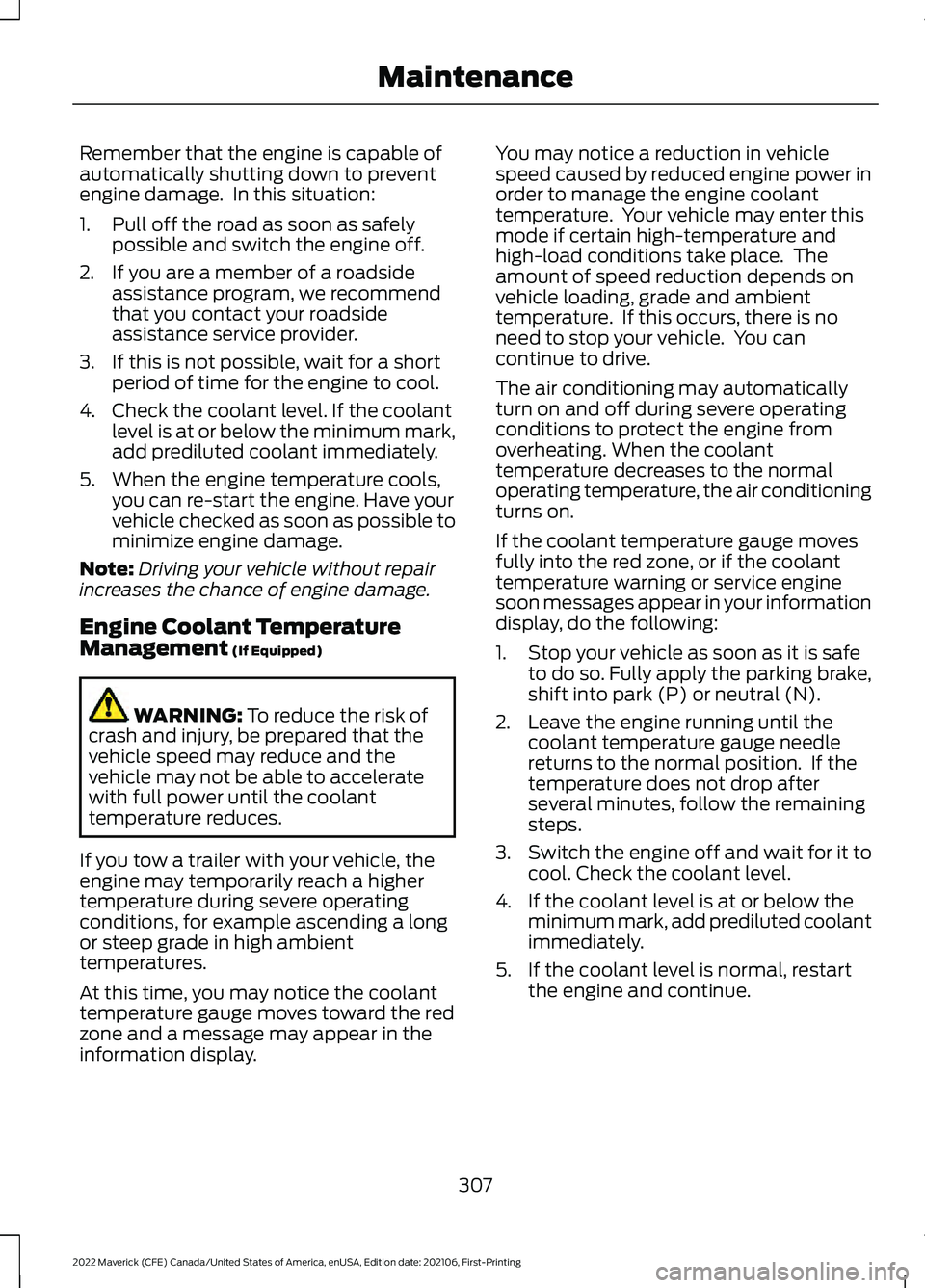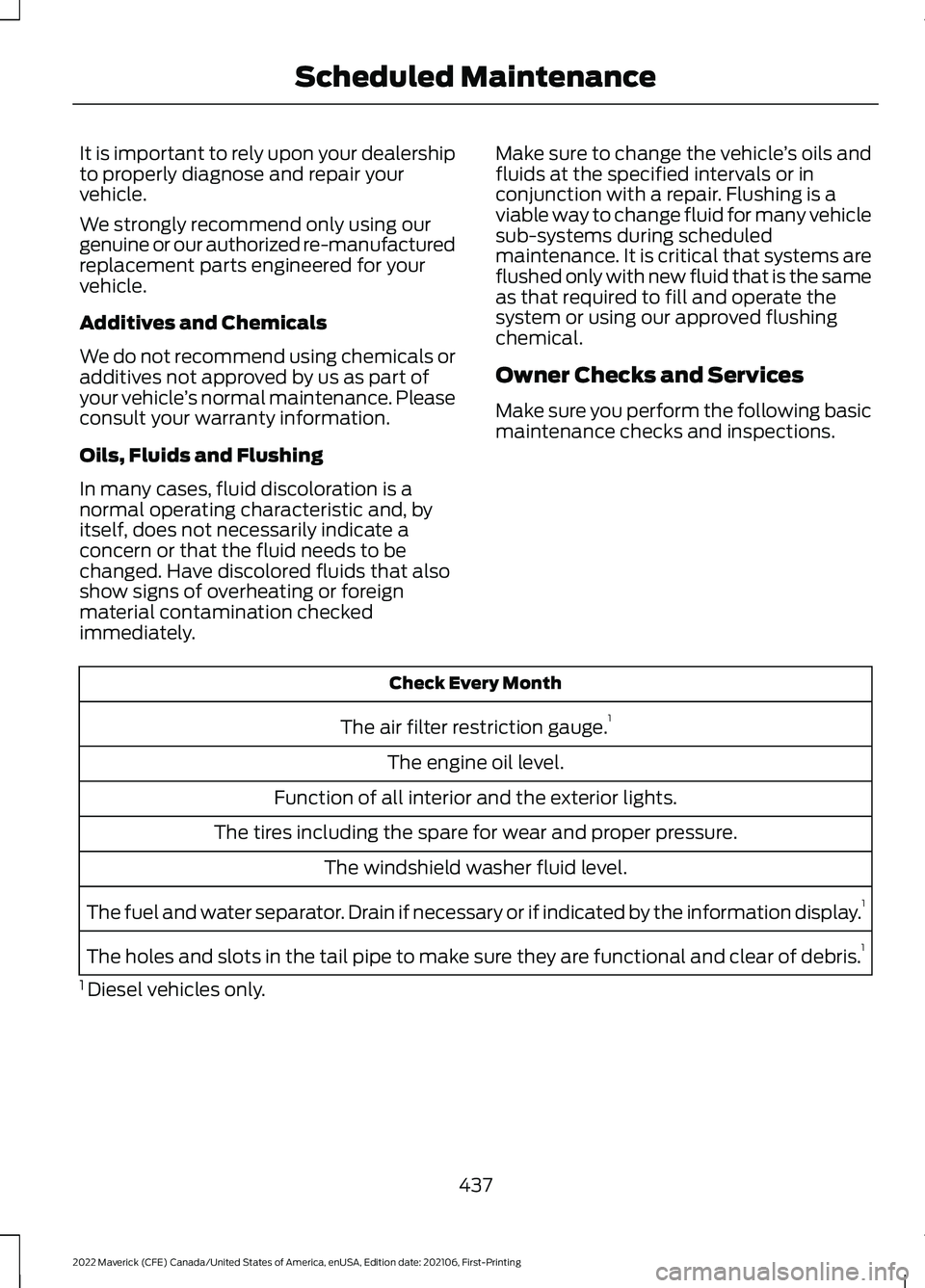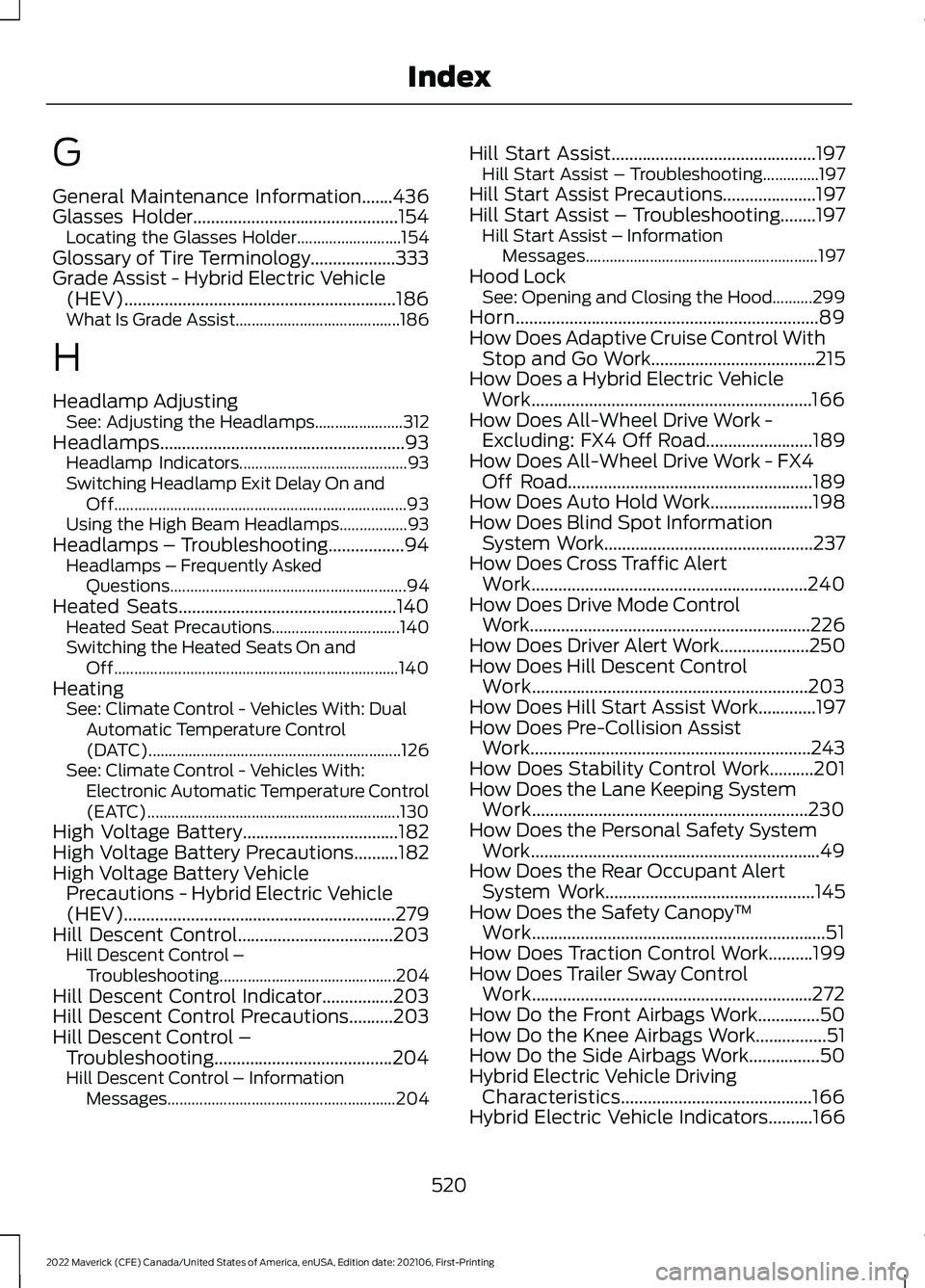2022 FORD MAVERICK heating
[x] Cancel search: heatingPage 308 of 533

WARNING: Do not put coolant in
the windshield washer reservoir. If
sprayed on the windshield, coolant could
make it difficult to see through the
windshield.
Note: Do not use stop leak pellets, cooling
system sealants, or non-specified additives
as they can cause damage to the engine
cooling or heating systems. Resulting
component damage may not be covered by
the vehicle Warranty.
Note: Automotive fluids are not
interchangeable.
It is very important to use prediluted
coolant approved to the correct
specification in order to avoid plugging the
small passageways in the engine cooling
system. See
Capacities and
Specifications (page 355). Do not mix
different colors or types of coolant in your
vehicle. Mixing of engine coolants or using
an incorrect coolant may harm the engine
or cooling system components and could
void the vehicle Warranty.
Note: If prediluted coolant is not available,
use the approved concentrated coolant
diluting it to 50/50 with deionized or
distilled water. See
Capacities and
Specifications (page 355). Using water that
ha
s not been deionized may contribute to
deposit formation, corrosion and plugging
of the small cooling system passageways.
To top up the coolant level do the
following:
1. Unscrew the cap slowly. Any pressure escapes as you unscrew the cap.
2. Add enough prediluted coolant to reach the correct level.
Note: We do not recommend the use of
recycled coolant. 3.
Replace the coolant reservoir cap. Turn
the cap clockwise until it contacts the
hard stop.
4. Check the coolant level in the coolant reservoir the next few times you drive
your vehicle. If necessary, repeat step
2.
If you have to add more than
1.1 qt (1 L) of
engine coolant per month, have your
vehicle checked as soon as possible.
Operating an engine with a low level of
coolant can result in engine overheating
and possible engine damage.
In case of emergency, you can add a large
amount of water without engine coolant
in order to reach a vehicle service location.
Service your vehicle as soon as possible.
Water alone, without engine coolant, can
cause engine damage from corrosion,
overheating or freezing.
Do not use the following as a coolant
substitute, as they can cause engine
damage from overheating or freezing:
• Alcohol.
• Methanol.
• Brine.
• Any coolant mixed with alcohol or
methanol antifreeze.
Do not add extra inhibitors or additives to
the coolant. These can be harmful and
compromise the corrosion protection of
the coolant.
Severe Climates
If you drive in extremely cold climates, you
may need to increase the coolant
concentration above 50%.
Note: A coolant concentration of 60%
provides improved freeze point protection.
Coolant concentrations above 60%
decrease the overheat protection
characteristics of the coolant and could
cause engine damage.
305
2022 Maverick (CFE) Canada/United States of America, enUSA, Edition date: 202106, First-Printing Maintenance
Page 310 of 533

Remember that the engine is capable of
automatically shutting down to prevent
engine damage. In this situation:
1. Pull off the road as soon as safely
possible and switch the engine off.
2. If you are a member of a roadside assistance program, we recommend
that you contact your roadside
assistance service provider.
3. If this is not possible, wait for a short period of time for the engine to cool.
4. Check the coolant level. If the coolant level is at or below the minimum mark,
add prediluted coolant immediately.
5. When the engine temperature cools, you can re-start the engine. Have your
vehicle checked as soon as possible to
minimize engine damage.
Note: Driving your vehicle without repair
increases the chance of engine damage.
Engine Coolant Temperature
Management (If Equipped) WARNING:
To reduce the risk of
crash and injury, be prepared that the
vehicle speed may reduce and the
vehicle may not be able to accelerate
with full power until the coolant
temperature reduces.
If you tow a trailer with your vehicle, the
engine may temporarily reach a higher
temperature during severe operating
conditions, for example ascending a long
or steep grade in high ambient
temperatures.
At this time, you may notice the coolant
temperature gauge moves toward the red
zone and a message may appear in the
information display. You may notice a reduction in vehicle
speed caused by reduced engine power in
order to manage the engine coolant
temperature. Your vehicle may enter this
mode if certain high-temperature and
high-load conditions take place. The
amount of speed reduction depends on
vehicle loading, grade and ambient
temperature. If this occurs, there is no
need to stop your vehicle. You can
continue to drive.
The air conditioning may automatically
turn on and off during severe operating
conditions to protect the engine from
overheating. When the coolant
temperature decreases to the normal
operating temperature, the air conditioning
turns on.
If the coolant temperature gauge moves
fully into the red zone, or if the coolant
temperature warning or service engine
soon messages appear in your information
display, do the following:
1. Stop your vehicle as soon as it is safe
to do so. Fully apply the parking brake,
shift into park (P) or neutral (N).
2. Leave the engine running until the coolant temperature gauge needle
returns to the normal position. If the
temperature does not drop after
several minutes, follow the remaining
steps.
3. Switch the engine off and wait for it to
cool. Check the coolant level.
4. If the coolant level is at or below the minimum mark, add prediluted coolant
immediately.
5. If the coolant level is normal, restart the engine and continue.
307
2022 Maverick (CFE) Canada/United States of America, enUSA, Edition date: 202106, First-Printing Maintenance
Page 440 of 533

It is important to rely upon your dealership
to properly diagnose and repair your
vehicle.
We strongly recommend only using our
genuine or our authorized re-manufactured
replacement parts engineered for your
vehicle.
Additives and Chemicals
We do not recommend using chemicals or
additives not approved by us as part of
your vehicle
’s normal maintenance. Please
consult your warranty information.
Oils, Fluids and Flushing
In many cases, fluid discoloration is a
normal operating characteristic and, by
itself, does not necessarily indicate a
concern or that the fluid needs to be
changed. Have discolored fluids that also
show signs of overheating or foreign
material contamination checked
immediately. Make sure to change the vehicle
’s oils and
fluids at the specified intervals or in
conjunction with a repair. Flushing is a
viable way to change fluid for many vehicle
sub-systems during scheduled
maintenance. It is critical that systems are
flushed only with new fluid that is the same
as that required to fill and operate the
system or using our approved flushing
chemical.
Owner Checks and Services
Make sure you perform the following basic
maintenance checks and inspections. Check Every Month
The air filter restriction gauge. 1
The engine oil level.
Function of all interior and the exterior lights.
The tires including the spare for wear and proper pressure. The windshield washer fluid level.
The fuel and water separator. Drain if necessary or if indicated by the information display. 1
The holes and slots in the tail pipe to make sure they are functional and clear of debris. 1
1 Diesel vehicles only.
437
2022 Maverick (CFE) Canada/United States of America, enUSA, Edition date: 202106, First-Printing Scheduled Maintenance
Page 523 of 533

G
General Maintenance Information.......436
Glasses Holder..............................................154
Locating the Glasses Holder.......................... 154
Glossary of Tire Terminology...................333
Grade Assist - Hybrid Electric Vehicle (HEV).............................................................186
What Is Grade Assist......................................... 186
H
Headlamp Adjusting See: Adjusting the Headlamps...................... 312
Headlamps.......................................................93 Headlamp Indicators.......................................... 93
Switching Headlamp Exit Delay On and Off........................................................................\
. 93
Using the High Beam Headlamps.................93
Headlamps – Troubleshooting.................94
Headlamps – Frequently Asked
Questions........................................................... 94
Heated Seats
.................................................140
Heated Seat Precautions................................ 140
Switching the Heated Seats On and Off....................................................................... 140
Heating See: Climate Control - Vehicles With: Dual
Automatic Temperature Control
(DATC)............................................................... 126
See: Climate Control - Vehicles With: Electronic Automatic Temperature Control
(EATC)............................................................... 130
High Voltage Battery...................................182
High Voltage Battery Precautions..........182
High Voltage Battery Vehicle Precautions - Hybrid Electric Vehicle
(HEV).............................................................279
Hill Descent Control
...................................203
Hill Descent Control –
Troubleshooting............................................ 204
Hill Descent Control Indicator................203
Hill Descent Control Precautions..........203
Hill Descent Control – Troubleshooting
........................................204
Hill Descent Control – Information
Messages......................................................... 204Hill Start Assist..............................................197
Hill Start Assist – Troubleshooting..............197
Hill Start Assist Precautions.....................197
Hill Start Assist – Troubleshooting........197 Hill Start Assist – Information
Messages.......................................................... 197
Hood Lock See: Opening and Closing the Hood..........299
Horn
....................................................................89
How Does Adaptive Cruise Control With Stop and Go Work.....................................215
How Does a Hybrid Electric Vehicle Work...............................................................166
How Does All-Wheel Drive Work - Excluding: FX4 Off Road........................189
How Does All-Wheel Drive Work - FX4 Off Road
.......................................................189
How Does Auto Hold Work.......................198
How Does Blind Spot Information System Work
...............................................237
How Does Cross Traffic Alert Work..............................................................240
How Does Drive Mode Control Work
...............................................................226
How Does Driver Alert Work....................250
How Does Hill Descent Control Work..............................................................203
How Does Hill Start Assist Work.............197
How Does Pre-Collision Assist Work...............................................................243
How Does Stability Control Work..........201
How Does the Lane Keeping System Work..............................................................230
How Does the Personal Safety System Work.................................................................49
How Does the Rear Occupant Alert System Work
...............................................145
How Does the Safety Canopy ™
Work..................................................................51
How Does Traction Control Work..........199
How Does Trailer Sway Control Work...............................................................272
How Do the Front Airbags Work..............50
How Do the Knee Airbags Work................51
How Do the Side Airbags Work................50
Hybrid Electric Vehicle Driving Characteristics
...........................................166
Hybrid Electric Vehicle Indicators..........166
520
2022 Maverick (CFE) Canada/United States of America, enUSA, Edition date: 202106, First-Printing Index